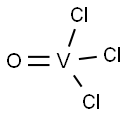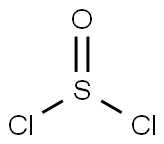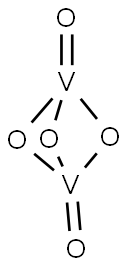Chemical Properties
Vanadium(V) oxytrichloride (VOCl3) is readily hydrolyzed and forms coordination compounds with simple donor molecules, eg, ethers, but is reduced by reaction with sulfur-containing ligands and molecules. It is completely miscible with many hydrocarbons and nonpolar metal halides, eg, TiCl4, and it dissolves sulfur.
Chemical Properties
Lemon-yellow liquid. Nonionizing solvent. Dissolves
most nonmetals; dissolves and/or reacts with
many organic compounds; hydrolyzes in moisture.
Uses
Vanadium(V) trichloride oxide is used as a catalyst in olefin polymerization reaction, especially for the production of ethylene-propylene rubber. It is also used to synthesis organovanadium compounds and as a mordant in dyeing. It acts as a precursor to prepare vanadium pentoxide, vanadyl dichloride and dioxovanadium monochloride. Further, it serves as a reagent and a strong oxidizing agent in organic synthesis.
Uses
Catalyst in olefin polymerization (ethylenepropylene
rubber) organovanadium synthesis.
Air & Water Reactions
Fumes in air. Reacts with moist air to form vanadic acid and hydrochloric acid fumes [Von Schwartz 1918. p.321]. Reacts exothermically with water to generate acidic fumes and acidic solutions. Violently hygroscopic.
Reactivity Profile
VANADIUM(V) TRICHLORIDE OXIDE is incompatible with bases, including amines, with strong oxidizing agents, and with alcohols. May react vigorously or explosively if mixed with diisopropyl ether or other ethers in the presence of trace amounts of metal salts [J. Haz. Mat., 1981, 4, 291]. Combination with sodium metal led to a violent explosion [Bretherick 5th ed., 1995].
Health Hazard
Inhalation of vapor causes irritation of nose and throat. Ingestion causes irritation of mouth and stomach. Contact with eyes or skin causes severe irritation.
Fire Hazard
Special Hazards of Combustion Products: Irritating fumes of hydrogen chloride may form in fires.
Flammability and Explosibility
Non flammable
reaction suitability
reagent type: catalyst
core: vanadium
Safety Profile
Poison by ingestion. A
corrosive irritant to skin, eyes, and mucous
membranes. Explosive reaction with
sodmm. Violently hygroscopic. Violent
reaction with rubidium (at 6OoC), potassium.
When heated to decomposition it emits
toxic fumes of VOx and Cl-. See also
VANADIUM COMPOUNDS and
HYDROCHLORIC ACID.
Purification Methods
VOCl3 should be lemon yellow in colour. If it is red, it may contain VCl4 and Cl2. Fractionally distil it, and then redistil it over metallic Na, but be careful to leave some residue because the residue can become EXPLOSIVE in the presence of the metal. USE A SAFETY SHIELD and avoid contact with moisture. It readily hydrolyses to vanadic acid and HCl. Store it in a tightly closed container or in sealed ampoules under N2. [Brown & Griffitts Inorg Synth I 106 1939, Brown & Griffitts Inorg Synth IV 80 1953.]




